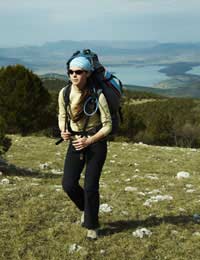A Hiking Emergency Survival Kit

For those who are planning hiking in the great outdoors no trip should be without an emergency survival kit. Most walking trips should go off without a hitch. Nevertheless, it makes sense to be prepared for the unexpected. You may encounter sudden storms, get injured, become stranded or lose your way, so a survival kit means better safe than sorry.
There are numerous emergency survival kits already made up which you can buy from outdoor adventure centres, tailor made for a variety of different activities, from land based adventures to water sports. However, many walking enthusiasts prefer to devise their own specifically based on the type of hiking they'll be undertaking, the length of the walk and the terrain they'll be crossing. Other considerations might include the weather, alongside any specific medications you might need to take.
Putting An Emergency Survival Kit Together
If you're putting your own emergency survival kit together, you should plan for the worst case scenario. Especially if you're not carrying camping equipment, you should take some form of waterproof and windproof material which you can erect as a makeshift shelter when hiking. Waterproof matches are a must (don't forget to keep them in a waterproof container). For back up, you should also take a secondary method of lighting a fire such as creating fire by friction. Being able to create a flame using traditional methods is not easily learned but is an extremely useful skill and also has the effect of bringing you closer to nature when walking. The ability to create fire is crucial in a survival situation and serves many purposes. It provides warmth, heat for cooking and can also be used to create smoke to attract attention in a rescue situation.Other useful items for the outdoors are a knife, a torch, a candle, some cord or rope, a spare compass, some water purification tablets and, of course, it should also include your first aid kit. Your kit should also contain some basic additional food and water supplies and, perhaps, an additional fleece to keep you warm.
Remember The Basics In Your Survival Kit
The key to surviving an emergency situation lies in understanding the basics of survival. These are:- Shelter
- Warmth
- Food and water
- Health and first aid
- Signalling for help
These issues should always be at the forefront of your mind when putting together your emergency kit. As such, here are some other useful items you might consider taking.
Other Useful Items For Your Survival Kit
Dark shoe polish can be used as fuel for a fire and the smell it gives off when used this way is also good at warding off animals, which can be important in the outdoors. Iodine tablets make a good alernative if you haven't got a water purification filter. A basic fishing line and a couple of hooks can sometimes be the difference between eating or not, so make sure they're in your emergency survival kit when hiking. Similarly, a snare wire is useful for catching small land based animals for food. A small mirror can make a useful signalling device and a magnifying glass can help to create fire.Ultimately, what you'll include in your emergency survival kit will be down to your own judgement, perhaps based on previous experience of a similar hiking trip you've undertaken and, as long as you remember the basics, you should be able to prepare for most eventualities. Along with the survival kit itself, it's important to know how each item fits into the plan and know how to use all of its contents, remembering to get your priorities right in the event that you have to implement your emergency strategy outdoors.
- A First Aid Kit for Hikers
- Daysacks and Hydration Packs
- How to Prepare for the Hiking Season
- How Much Should You Carry in Your Backpack?
- What Food Should You Take Hiking?
- Walkers' Navigation Tools: Maps, Compass, GPS...
- Safety Products for Walking
- How to Choose Walking Shoes and Hiking Boots
- Navigation Technology for Walkers
- Protective Clothing for Walkers
- The Right Backpack For Hiking


Re: Walking on Roads
I have never attempted any form of hiking. This year i am 87, I’m pretty’s fit, I walk with dog between five and. Six miles every day, summer and…
Re: Starting a Walking Club
Hi I'm a naturist from North Wales and wanted to reach out to people that would like to join a clothing optional walk what's the best way…
Re: Starting a Walking Club
Do I need insurance for a walk/run group?. It’s a completely free group so no joining fee or charges. It’s run by volunteers. I don’t…
Re: Join A Walking Club
I need to hike...do something for my self...I love the outdoors and hiking...I need to meet new friends...who injoys the outdoors like…
Re: Starting a Walking Club
What sort of paperwork/ registration/ insurance might you need for walking group?
Re: Join A Walking Club
Hi, Any advice on liability/protecting yourself when setting up a walking club? What if someone hurts themselves? Thanks, Sam
Re: Starting a Walking Club
Hello, Do you know of any software that facilitates putting together walking/hiking clubs programme schedule? I am looking for…
Re: Join A Walking Club
I am looking to join a walking/hiking club in the Southampton/Hampshire area. I am 50 and have signed up for London to Brighton Challenge and…
Re: Join A Walking Club
Looking for a short walk partner n to make friends in tipton area of west midlands
Re: Join A Walking Club
Hi I am 33 and am looking to join a walking club for health and social reasons. I currently live in huntingdonshire.